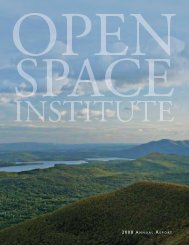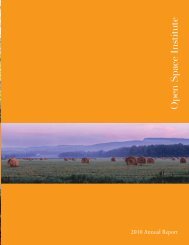OSI Annual Report 2005 - Open Space Institute
OSI Annual Report 2005 - Open Space Institute
OSI Annual Report 2005 - Open Space Institute
You also want an ePaper? Increase the reach of your titles
YUMPU automatically turns print PDFs into web optimized ePapers that Google loves.
4<br />
Dear Friends,<br />
“IT IS NOT ENOuGH TO uNDERSTAND THE NATuRAL WORLD;<br />
THE POINT IS TO DEFEND AND PRESERVE IT.”<br />
For 40 years <strong>OSI</strong> has saved the open spaces that define our communities: farms, forests, parks, and waterfront.<br />
These places create common ground and experience for all of us to visit, enjoy, seek work, friendship and solitude.<br />
005 was no exception and in our expanding geography, <strong>OSI</strong> helped preserve 355,500 acres in 35 communities.<br />
Every year, it seems, conservation of private and public lands becomes more of a challenge,<br />
exacerbated recently by these disturbing trends:<br />
• Real estate values have escalated at unprecedented rates, particularly near water;<br />
• Traditional rural working lands – farms and forests – are being bought<br />
and converted to housing and commercial sprawl; and<br />
• Federal funding for conservation has been dramatically reduced, placing<br />
enormous pressure on strapped state and local budgets.<br />
Edward Abbey<br />
In the face of this sell-off of our natural real estate, we have opted to expand where we work, how we work, and with whom<br />
we work.We seek to be creative in our partnerships, to use every means we can to conserve our natural heritage, and<br />
forestall the conversion of open spaces into a built world. Over the next 5 years, it is projected that an average $1 trillion per<br />
year will be spent building new structures, mostly on natural lanscapes, resulting in as many buildings as exist in America today.<br />
Conservation investments, by way of contrast, are estimated at less than half of 1% of the real estate development capital.<br />
To respond to both the immediate and long-term threat to our open spaces, natural resources,<br />
and sense of community, we have expanded our agenda to:<br />
• Work in critical landscapes across a broader geography (discussed throughout this report);<br />
• Help ensure that regional and sustainable agriculture survives (see “The Good Earth” on pg 12);<br />
• Protect timberland, with ecological forestry, to protect jobs and nature (see “Helping Forests Grow” on pg 16);<br />
• Preserve the historic character of rural open spaces (discussed throughout this report);<br />
• Employ more sophisticated financing practices (read about our Conservation Finance Program on pg 14);<br />
• Define other ways, short of purchase, to conserve natural land values and resources<br />
(see page 18 to read about increased communications and public engagement); and<br />
• Leverage the assets of <strong>OSI</strong> and others to help land trusts conserve more land (see pg 14-17).<br />
Collectively, we have to be creative and intelligent in our effort to protect the natural heritage and open spaces of our<br />
farms, forests, and, communities.We need as much assistance as possible, and we thank our partners and supporters for<br />
providing counsel and help in 005, and on into the future.<br />
Sincerely,<br />
Kim Elliman CEO<br />
from the<br />
executives<br />
Joe Martens President




